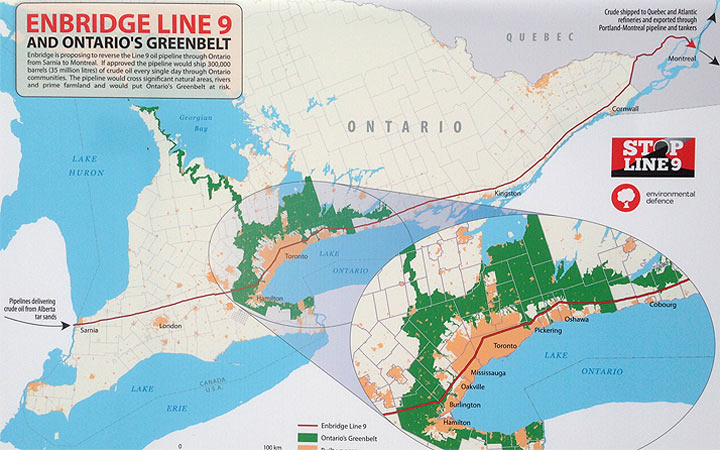TORONTO – Under heavy clouds and threat of rain, a coterie of Canadian musicians tried to turn concert-goers’ attention to a pipeline less than two kilometres away and 24 inches from Finch subway station.

Southern Ontarians could be forgiven for knowing little about the oil pipeline underneath their homes, roads and workplaces: Jan Morrissey, who lives about a kilometre from the pipeline in North York, wasn’t aware it existed.
Morrissey, a member of north Toronto’s Bayview-Cummer Neighbourhood Association, calls herself an “accidental activist.” She found out about Enbridge’s Line 9 pipeline through an email from an environmental group. When she attended a neighbourhood meeting earlier this year she said only three people in the crowd knew about Line 9.
Speaking to a crowd of civic-minded concert-goers Sunday, she called Enbridge’s attempt to make the community aware of their proposal “spectacularly ineffective.”
The National Energy Board (NEB) is holding public hearings, starting Tuesday in Montreal and in Toronto next week, on Enbridge’s plan to ship heavy crude oil from Ontario to Quebec. The Calgary-based company is asking permission to increase its capacity of oil through its Line 9 pipeline and switch from transporting light crude to heavy.
Enbridge says the plan is safe and relatively low-impact: The pipeline, after all, is already in the ground.
But environmentalists argue Enbridge’s plan for Line 9 would see Alberta heavy crude pumped from Sarnia to Montreal through a decades-old pipeline not built to handle the viscous substance. And they’re worried changes to federal rules could mean the plan’s approved without an environmental assessment.
Sunday’s “Rock the Line” concert, spearheaded by Environmental Defence and Canadian singer-songwriter Sarah Harmer and featuring the likes of Hayden, MINOTAURS and Gord Downie backed up by the Sadies. Hundreds attended the concert at Mel Lastman Square, which aimed to raise awareness and urge residents to take up the cause protesting Line 9.
Harmer, who will be one of 100 or so interveners at the NEB hearings, urged those involved to take the approach of “conservation first.”
“We have a massive responsibility as Canadians to speak up,” she said.
Line 9 runs through numerous communities in Ontario and Quebec – cutting through rivers, parks, backyards and transit corridors – many of those residents didn’t know the pipeline existed, let alone about Enbridge’s proposal.
- Trudeau tight-lipped on potential U.S. TikTok ban as key bill passes
- Canadian man dies during Texas Ironman event. Her widow wants answers as to why
- Hundreds mourn 16-year-old Halifax homicide victim: ‘The youth are feeling it’
- On the ‘frontline’: Toronto-area residents hiring security firms to fight auto theft
You can view a detailed map of Line 9’s route here.
In November of 2012, Enbridge filed an application asking the NEB to let it reverse the flow of a segment of the pipeline between North Westover, Ont., and Montreal. That application was approved in July 2012.
Now Enbridge wants to increase the pipeline’s capacity from 240,000 barrels per day to approximately 300,000 and change to the rules to allow heavy crude to be transported through Line 9. Currently, the pipeline carries light crude oil.
The energy distribution company says it has a safe record on Line 9, and that increasing the capacity to carry heavy crude and diluted bitumen will bolster “the security of Canada’s energy supply” while “safeguarding jobs.”
Environmentalists say the aging 38-year-old pipeline was never intended to transport heavy crude.
To allow it to flow through pipelines, tar-like bitumen is mixed with diluents the Natural Resources Defense Council says are highly corrosive and acidic – raising the risk of pipeline corrosion and oil spills.
Enbridge argues that diluted bitumen isn’t corrosive, citing a study from U.S.-based National Academy of Sciences. The study said that diluted bitumen doesn’t have a unique property that would make it any more corrosive than other crude oils.
Enbridge said it’s safe delivery record stands at 99.999 per cent, adding that anything less than a perfect safety record is “not good enough.”
Reports of oil leaking from pipelines across Canada are not uncommon.
In 2010, an Enbridge pipeline running underground from Griffith, Ind., to Sarnia, Ont., ruptured, spilling more than 3 million litres of oil into the Kalamazoo River and a tributary creek. The cleanup efforts have cost the company more than $1 billion so far, and are not yet completed.
If a spill occured on Line 9, Enbridge spokesperson Graham White said, the company would be on the hook for clean up and associated costs. But several groups in Ontario are afraid that it would in fact be local responders who would arrive to the scene of a spill first, with no proper training on how to handle it.
To find out what it’s like when oil runs through your backyard, click here.
Activists are particularly concerned that the pipeline route cuts through many watersheds, putting the drinking water of millions at risk.
Changes to federal environmental protections, pushed through as part of the government’s 2012 omnibus budget bill, mean Line 9 could get approved without an environmental assessment. Groups have already argued that changes to the NEB introduced in Bill C-38 has kept the public out of the consultation process.
Environmental Defence, Harmer and activists are urging residents to pressure the provincial government to step in and independently order an environmental assessment.
Ontario Premier Kathleen Wynne said in August environmental concerns over Line 9 will be addressed before any decisions are made.
Tim Gray, Environmental Defence’s new executive director, said Line 9 is an important issue not only for communities along the pipeline route but as an example of pipeline expansion happening all over Canada.
The National Energy Board is expected to decide on Enbridge’s application around the end of the year.

















Comments